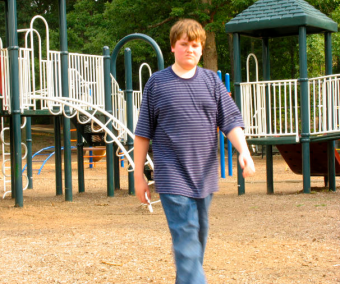
Bullying is nothing to take lightly. As a kid or teenager, it can be hard to stand up to a bully or tell someone you are being bullied. You may think no one will believe you or that the bully will just pick on you more. However, even if you are afraid, it is important to take a stand if you are being bullied. Otherwise, the bullying will continue, and that could lead to a lack of confidence, health problems or simply living your life in fear.
Dealing with Bullying
Bullying comes in multiple forms: verbal bullying, physical bullying, indirect bullying and cyber bullying. However, there are a few strategies for dealing with bullying you can use no matter what type of bullying you're experiencing. Knowing these strategies can help you stop a bully in its tracks.
Tell an Adult
TeensHealth from Nemours encourages you to tell an adult immediately about any cases of bullying. Often adults, especially teachers and students, know specific strategies for handling bullying. Some kids do not tell adults because they are afraid the bully with retaliate, but the adult does not have to let on that you were the one who reported the bully.
Don't Retaliate
Rosalind Wiseland, an author and educator who has dealt extensively with bullying, suggests that retaliating against a bully can cause the bullying to escalate. Calling a bully names, sending mean messages or hitting him back will only encourage him to do more to get to you.
Walk Away
The Montana Office of Public Instruction advises you to walk away from a bully. By walking away, you take away some of the bully's power and let the bully know she is not getting to you. If you cannot walk away and are not being physically harmed, simply ignore the bully until you can walk away or get the chance to tell someone else about it.
Keep Negative Emotions Hidden
According to KidsHealth, getting a negative reaction can give a bully a sense of power and let her know the bullying is successful. Even though it may be hard, try to hold off on crying or getting angry with the bully. This may only encourage the bully to continue.
Special Considerations for Different Types of Bullying
Verbal Bullying
Verbal bullying involves being called names, put down or intimidated through words. If someone is bullying you verbally, do not resort to saying hurtful things back. Instead, try the following strategies along with the suggestions above:
- Turn what the bully says into a joke.
- Surround yourself with positive thoughts.
- Find a witness for the verbal bullying. Ask a teacher to subtly pay extra attention when the bully talks to you in class or ask a friend to listen in when the bully talks to you.
Physical Bullying
Physical bullies intimidate, hit, push, kick and do other physical harm to their victims. If you are being physically bullied, you need to do something about it right away. Beyond telling an adult immediately, some suggestions for handling the bullying and preventing future physical bullying include:
- Make sure you are never alone. It is more difficult for a bully to strike with a friend by your side or lots of witnesses.
- Anticipate where the bully will be, and try to avoid the bully.
- If you are really hurt, tell the bully how hurt you are. Sometimes a bully doesn't realize the extent of his power and you telling him you're hurt can snap him back to reality.
Indirect Bullying
Indirect bullying involves excluding someone from a group or spreading rumors about someone. Often it can be difficult because you have no idea why people are spreading rumors about your or leaving you out too, but there are a few things you can do to make it easier:
- Spend time with friends or taking up new hobbies. If a specific group of people is excluding you, find a new group or do something else. You don't need them.
- Do not spread rumors about those who are bullying you.
- If you're being excluded, confront the bullies. Simply ask them what you did wrong. The answer may not be nice, but it may help you move on.
Cyber Bullying
Cyber bullying is bullying that happens online or through other electronic devices, such as cell phones or video games. People may say mean things about you, spread rumors or post inappropriate pictures. Often they may bully you anonymously or occasionally will bully while pretending to be someone else. A lot of older kids and teens cyber bully because they cannot see the person they are bullying, making it easier to be mean, but it is still just as serious. If you are being cyber bullied, check out some of the suggestions from Stop Cyber bullying and Netsmartz suggest you take the following steps:
- Save any e-mails, instant messages, text messages or photographs that may have been used as cyber bullying.
- Block anyone who sends you mean or inappropriate pictures or messages.
If You Witness Bullying
Witnessing bullying and not doing anything about it or choosing to agree with the bully can be just as bad as doing the actual bullying. If you see or hear about someone being bullied in any of the ways above, take a stand.
- Ask the bully to stop.
- Tell a teacher or parent about the bullying.
- Refuse to laugh at the bully or support the bully.
- Be a friend to the person being bullied.
- Encourage your friends to take a stand against bullying.
PBS Kids provides kids and teens with advice for taking an even bigger stance against bullying in school and in your community.
Advice for Adults
If you are an adult who has been made aware of or has witnessed bullying, stopbullying.gov offers advice on how to handle it. A few of the suggestions include:
- Don't ignore a case of bullying.
- Stay calm.
- Talk to all parties involved privately.
- Talk to all involved separately.
The National Crime Prevention Council also offers advice for helping parents recognize possible cases of bullying and help their children handle bullying.
Bullying Resources
If you want more information on what bullying is and is not or want to learn ways to take a stand against bullying, check out the following resources geared to stomping out bullying among kids and teens.
- Kidpower offers multiple resources on bullying and abuse prevention, including ways to "face bullying with confidence."
- Stomp Out Bullying encourages kids and teens to take a stand against bullying and has gained celebrity support.
- Pacer's National Bullying Prevention Center features videos, stories and a petition for kids to sign to put an end to bullying.
- The Bully Project, based on the popular film, offers stories and stats to encourage kids to stand up against bullying.
It's a Big Deal
Bullying is a big deal, and it does not need to happen. A bully isn't just a bad friend or someone who doesn't like you: this person is a real problem. Don't let you or your friends fall prey to some of the larger dangers of the world of bullying. If you see something, say something so that you can actually get away from the bully!







